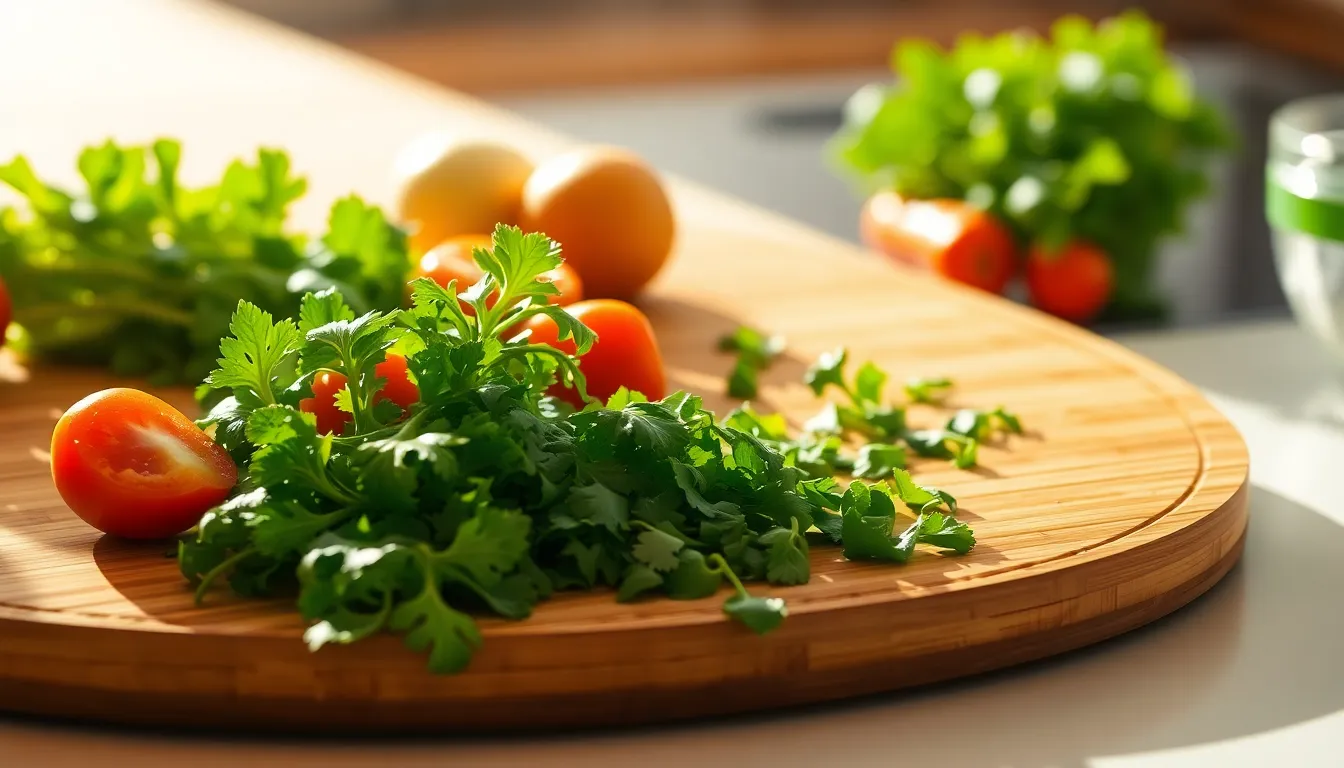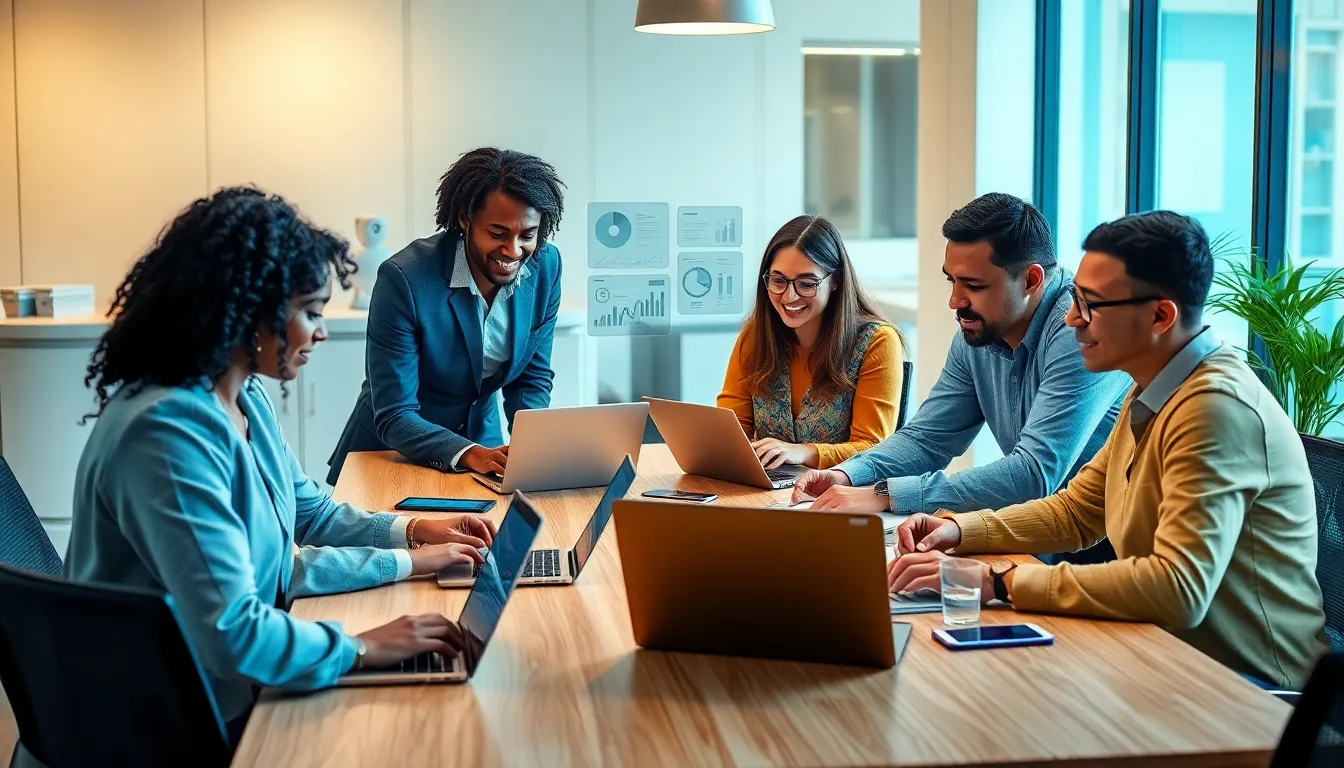In a world where plastic seems to be everywhere—like that one friend who overstays their welcome—it’s time to make a change in the kitchen. Enter the non-plastic cutting board, the unsung hero of culinary adventures. Not only do these boards help save the planet, but they also elevate your chopping game to Michelin-star levels.
Table of Contents
ToggleOverview Of Non-Plastic Cutting Boards
Non-plastic cutting boards offer several advantages, making them ideal for sustainable kitchens. Materials such as bamboo, wood, and composite fibers dominate this category. Each material provides unique benefits, including durability, knife-friendliness, and resistance to bacteria.
Bamboo cutting boards stand out for their eco-friendliness. This renewable resource grows quickly, making bamboo an excellent choice for sustainability. Their lightweight nature also enhances ease of use in various kitchen tasks.
Wooden cutting boards deliver a classic aesthetic and superior cutting performance. Hardwoods, like maple and walnut, resist scratches and dents well, preserving their surface for longer periods. Expert chefs often prefer these options for their ability to maintain sharp knives.
Composite cutting boards, made from resin and wood fibers, blend the strengths of both materials. These cutting boards resist warping and cracking, enhancing longevity. Their non-porous surface also minimizes bacterial growth, contributing to food safety.
Caring for non-plastic cutting boards requires specific maintenance. Regular oiling helps prevent drying and cracking in wooden and bamboo boards. Proper cleaning methods, like warm soapy water and air drying, extend each board’s life.
Choosing the right non-plastic cutting board hinges on personal preferences and cooking styles. Each option serves its purpose well, whether for slicing fruits, chopping vegetables, or preparing meats. By opting for these sustainable alternatives, individuals contribute positively to environmental conservation, highlighting their role in a greener kitchen.
Benefits Of Non-Plastic Cutting Boards

Non-plastic cutting boards offer significant advantages, especially in environmental conservation and health. Choosing these boards benefits both the planet and the kitchen experience.
Environmental Impact
Non-plastic cutting boards significantly reduce plastic waste. Bamboo is a highly renewable resource, making it a sustainable choice. Wood cutting boards promote responsible forestry practices, which help maintain ecosystems. Composite boards often utilize recycled materials, contributing to waste reduction. Switching to non-plastic alternatives supports a decrease in single-use plastics, aligning with global efforts to reduce environmental pollution.
Health Considerations
Health implications arise from using traditional plastic boards. Non-plastic cutting boards harbor fewer bacteria, as materials like bamboo and wood possess natural antibacterial properties. Wooden boards deter moisture retention, reducing the likelihood of bacterial growth. Composite boards offer a robust surface that resists scratching, preventing bacteria from becoming embedded. Opting for these non-plastic options promotes safer food preparation and contributes to better overall health outcomes.
Types Of Non-Plastic Cutting Boards
Non-plastic cutting boards come in various materials, each offering distinct benefits. Understanding these types helps in choosing the right board for specific culinary needs.
Wood Cutting Boards
Wood cutting boards, often handcrafted, showcase both beauty and functionality. They feature durability that withstands heavy use. Many chefs prefer wood for its ability to maintain sharp knives, minimizing wear on blades. Available in various species like maple or walnut, these boards offer unique aesthetics. With proper care, wood boards can last a lifetime. They also possess natural antibacterial properties that help reduce the risk of foodborne illnesses.
Bamboo Cutting Boards
Bamboo cutting boards stand out due to their eco-friendliness and strength. These boards are lightweight, making them easy to handle during food preparation. Bamboo grows rapidly, ensuring a sustainable option. The surface is naturally resistant to bacteria, which enhances food safety. Many users appreciate bamboo boards for their affordability and attractive design. Additionally, they generally require less maintenance compared to traditional wood.
Glass Cutting Boards
Glass cutting boards present a sleek and modern alternative. They resist staining and odors, ensuring hygienic food preparation. Easy to clean, glass boards can be sanitized in a dishwasher. However, they can be harsh on knife edges due to their rigid surface. Many choose glass for its visual appeal and ability to double as serving platters. It’s important to handle glass cutting boards carefully to avoid chipping or breaking.
Criteria For Choosing The Best Non-Plastic Cutting Board
Selecting a non-plastic cutting board involves several critical factors, ensuring both functionality and longevity in the kitchen.
Durability
Durability ranks high in importance when choosing a cutting board. Bamboo cutting boards generally resist warping and cracking, thanks to the material’s natural strength. Wooden boards, particularly those made from hardwoods like maple or walnut, withstand heavy use and offer an appealing aesthetic. Composite cutting boards boast exceptional durability, often lasting several years without showing significant wear. Selecting a board based on its durability ensures it can handle the demands of daily food preparation.
Maintenance
Maintenance plays a crucial role in preserving the lifespan of a cutting board. Bamboo and wood boards require regular oiling to keep them hydrated, preventing splits and stains. Cleaning these boards typically involves mild soap and warm water, avoiding harsh chemicals. Composite boards, however, often allow for dishwasher safe cleaning, making them convenient for busy cooks. Proper maintenance techniques help maximize the board’s durability and function, ensuring excellent performance.
Size And Thickness
Size and thickness impact the usability and stability of a cutting board. Compact boards work well in smaller kitchens, while larger boards offer ample space for food preparation. Thickness ranges usually between 0.5 to 1.5 inches; thicker boards provide better stability against movement during cutting. Choosing an appropriate size and thickness aligns the cutting board with specific culinary tasks, enhancing the overall cooking experience.
Top Picks For The Best Non-Plastic Cutting Board
This section highlights top choices for non-plastic cutting boards that combine sustainability, durability, and performance.
Product Reviews
Bamboo Cutting Board by Greener Chef: Highly rated for its eco-friendly materials, this board is lightweight and resistant to bacteria. Users appreciate its smooth surface, which doesn’t dull knives easily.
Wood Cutting Board by John Boos: Crafted from hard maple, this board captivates with its classic look and functionality. Many chefs value its durability and ability to withstand heavy use over time.
Composite Cutting Board by Epicurean: Designed for strength and versatility, this composite board excels in performance. Many users like that it’s dishwasher safe and prevents bacteria growth, making it a popular choice.
Comparative Analysis
Bamboo boards offer an attractive balance of aesthetics and sustainability. They weigh less, making them easy to handle. Wooden boards boast longevity and resist wear, providing a charming presence in any kitchen.
Composite boards shine in practicality, presenting a modern alternative. They resist scratches, maintaining a hygienic surface. Durability varies, with bamboo being lightweight while wooden options offer robust stability and lasting use. Each type serves specific cooking needs, depending on user preferences and cooking styles.
Choosing a non-plastic cutting board is a step towards a healthier kitchen and a more sustainable lifestyle. By opting for materials like bamboo, wood, or composite fibers, individuals can enhance their cooking experience while minimizing environmental impact. Each type of board offers unique benefits that cater to various culinary needs and preferences.
Investing in a high-quality non-plastic cutting board not only promotes food safety but also aligns with responsible consumption practices. With proper care and maintenance, these boards can last for years, making them a smart choice for any home chef. Transitioning away from plastic cutting boards is not just a trend; it’s a commitment to healthier cooking and a greener planet.



